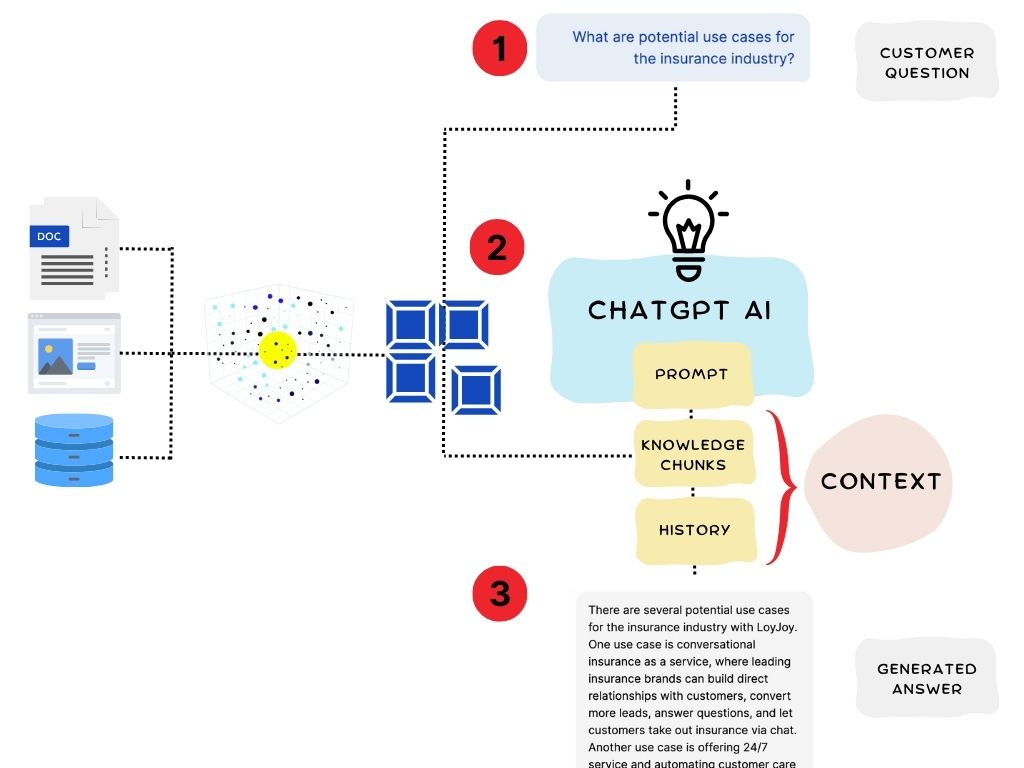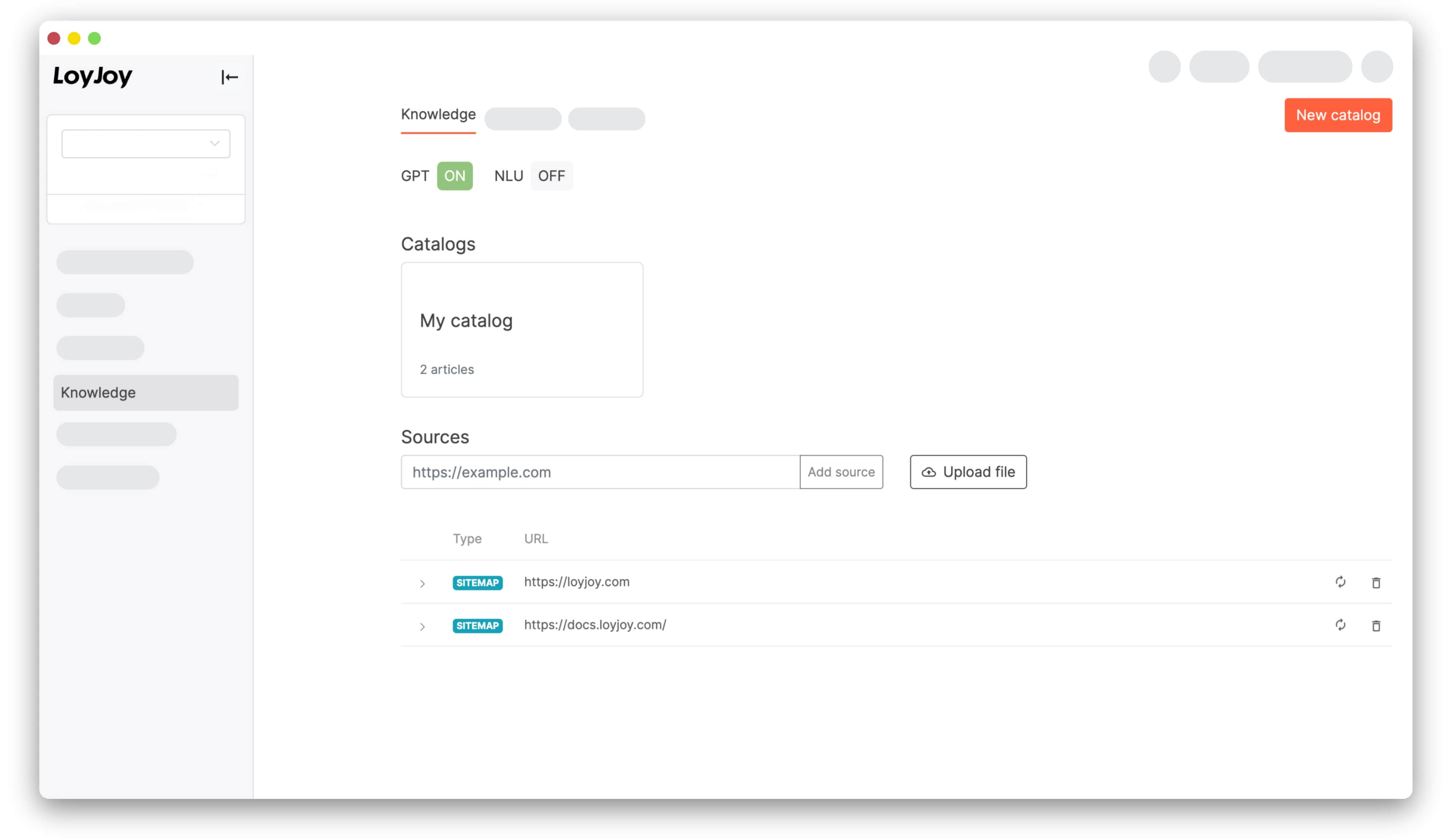Retrieval Augmented Generation
What Is RAG and Why Is It Currently the Top Topic in AI?
In the rapidly evolving world of generative AI, one term is currently unavoidable. Three letters: RAG. Retrieval Augmented Generation is a sought-after technology that combines information retrieval with large language models. In other words: the generative AI is augmented (enriched) with additional information. This additional information comes from a knowledge database, such as the one contained in LoyJoy. Many companies use the capabilities of RAG on the LoyJoy Conversational Platform to offer their customers a company-specific, intelligent chat experience! 💬
What is RAG? 🤖
But what exactly is RAG and how does it work? RAG systems integrate a retrieval component that searches for relevant information in a knowledge base, such as a company's website or documents. This retrieval component is usually a semantic search. The retrieved information is then integrated into the prompt of a language model like GPT or Claude 3 to guide the generation process and produce highly precise and context-related answers. In this way, the LLM can not only use the information it already possesses but is also supplemented with the information the company wants to use in its customer conversations.

How does LoyJoy use RAG?
LoyJoy enables companies to maintain their own knowledge database in the LoyJoy Platform using RAG. Websites can be read directly into LoyJoy, documents can be uploaded, and data can be imported via API. The knowledge database contains not only your documents and texts but also the associated "embeddings", i.e., the mathematical vectors from which the LLM generates the text output. The customer inquiry also contains "embeddings", and a search algorithm searches the knowledge database for associated information. These knowledge chunks are "extracted" and passed to the LLM to generate a response using the prompt and system message. In this way, the AI generates answers that are not only based on the user's prompts and chat history but also draw from the wealth of information provided in the knowledge chunks. 📚

Let's take a closer look at the RAG process:
The starting point is the customer inquiry.
Documents, websites, and other source data form the chatbot's knowledge database. Upon an inquiry, a semantic algorithm first searches the knowledge database for relevant information. Contextually relevant text fragments are identified. The so-called "Knowledge Chunks".
Using this "Context", a contextually appropriate and personalized answer is then generated by the AI. If necessary, the history of the conversation is also taken into account.
RAG Success Factors ✅
Now let's look at some success factors of RAG on the LoyJoy platform. With the following tricks, RAG enriches every customer chat!
One of the key factors for the success of RAG is focusing on quality over quantity. Instead of concentrating on the sheer amount of data (e.g., the entire company website), priority is given to including high-quality and relevant information in the knowledge base. This approach ensures that the AI generates precise and useful answers instead of being flooded with irrelevant or redundant data.
Another important aspect is avoiding repetitive content in the knowledge database, such as SEO content. By carefully curating the information and minimizing duplicates, you optimize the most relevant information for each user query. This not only improves the efficiency of the system but also enhances the user experience by delivering accurate and targeted responses.
The best part: Implementing RAG on the LoyJoy platform requires no training! LoyJoy does the groundwork for you, allowing you to focus on curating the knowledge database and creating customer experiences. With the LoyJoy platform, companies can leverage the power of RAG without needing extensive technical expertise or resources.
Use RAG in LoyJoy in just a few minutes: See for yourself!
An outstanding feature of the LoyJoy Conversational Platform is its user-friendly interface that allows you to create chatbots via drag and drop. This intuitive design enables your customers to quickly and easily ask questions and receive answers from the AI, creating a seamless and engaging interaction. Whether it's a customer seeking product information or an employee needing assistance, the RAG-powered LoyJoy chatbot is always ready to help. 💡
By the way: If RAG is not the right solution for your use case, you can also resort to specially trained models.
The steps in LoyJoy
First, you need to create a new experience using the LoyJoy platform or modify an existing experience. Then, go to the knowledge area, and you can easily add individual documents like PDFs or your entire website as a source for your knowledge database.
 And just like that, your LoyJoy chatbot can use your knowledge data to generate tailored responses for your customers!
And just like that, your LoyJoy chatbot can use your knowledge data to generate tailored responses for your customers!
In summary, Retrieval Augmented Generation is a game-changer in the world of conversational AI. By leveraging RAG and the LoyJoy platform, companies can harness the full potential of their customer data, deliver precise and personalized answers, and elevate their customer experience to a new level with little effort. 🚀
So, what are you waiting for? Contact us and embrace the future of conversational AI with the LoyJoy Conversational Platform, and experience the transformative power of Retrieval Augmented Generation for your business today! 💪